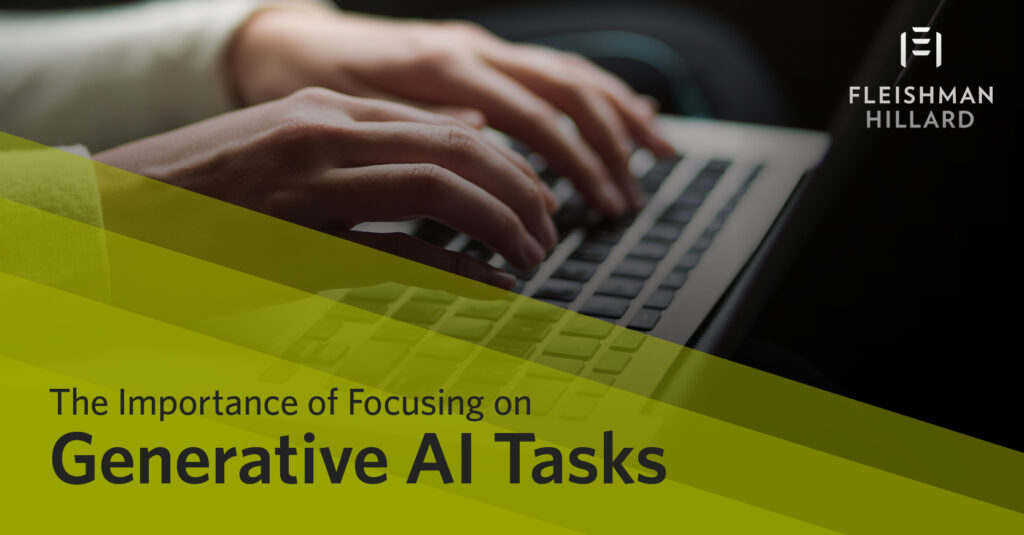The Importance of Focusing on Tasks, Not Jobs, with Generative AI
To all the generative AI fearmongers: Don’t we all complain that there’s never enough time in the day to do the critical, long-term, deep-thinking work?
It’s time to reframe the discussion around the impact of generative AI from jobs and roles to tasks and deliverables. Too many of today’s generative AI discussions focus on the number of jobs that will be eliminated rather than considering all the new opportunities that can be unlocked when we automate tasks, thus freeing up more time for higher-value work and the eventuality of new roles.
And let’s be honest … we have been using automation, natural language processing and computer vision to complete tasks long before the surge in popularity of generative AI. That’s because when technology truly does its job, it becomes nearly invisible. While the concerns may be altruistic, they’re also misguided. It’s not the technology that matters as much as the benefits you derive. It’s the suggested cart item, the grammatical correction, and the hyper-relevant search result. It’s the surfaced insight, seamless customer experience and so on. When we embrace the potential value to be gained, our mindset can shift from worrying about AI replacing jobs to reimagining a future where AI can enhance and augment our own human excellence.
When humans focus solely on the task at hand, we prioritize near-term deadlines at the cost of longer-term, higher-level ideas and creativity. For example, in PR we may rush to finish a measurement report only to quickly move to the next one when that time could be better spent developing more actionable insights based on the data, which can then be used to develop more strategic and impactful plans.
And what happens after tasks? When generative AI takes on enough tasks, it can create a full-time role just to manage and optimize all those tasks. For example, a new type of AI graphics manager can focus on generating the best possible images to convey a story. Meanwhile, the roles of traditional graphics managers have moved on – they’re now spending their time digging into data and creative sources to come up with more effective visual concepts, out of which generative AI can rapidly create 100 or more variations for consideration. This will provide more choice and options at scale — and for a fraction of the cost — while also freeing up the designers to take on more fulfilling work.
This certainly isn’t the first time that communications roles have evolved in ways we previously couldn’t have imagined. Let’s look at two historical PR examples where technology impacted what we do daily and was perceived as a significant threat to jobs but ended up creating new and better opportunities for individuals in those roles.
First, those of us working in this industry in the ‘90s can recall when media lists began to move online (for those starting after 2000, lists were previously created manually from a printed directory of media contacts).
- The task: Creating a media list.
- New opportunity created: More time for counselors to develop better story pitches and cultivate deeper relationships with reporters, analysts, and later bloggers and influencers.
- Result: New roles emerged, like media and data analytics, which help our media relations pros determine which outlets and story angles will deliver the most impact.
Now, let’s consider the seismic shift that happened because of AI-powered video editing.
- The task: Studio editing.
- New opportunity created: Producing higher-quality video became accessible and attainable to all, enabling talent to develop more customized video solutions at a fraction of the cost.
- Result: As video production became significantly more affordable and internet/mobile bandwidth expanded rapidly, video became much more common on social media, leading to even more demand for video content from brands and, therefore,more creative and production jobs in PR.
What many fear about change is often only the mind’s reaction to something unfamiliar. Change often happens one step – or task – at a time. When real change comes to fruition, new roles and higher-value opportunities inevitably arise to meet the demands of the latest technology. It’s everywhere in industry’s history – from horses to cars, factories to robots and typewriters to computers. So far, history is repeating itself, and that’s creating even more opportunities, one Gen-AI powered task at a time.
This communication is offered as general background and insight as of the date of publication, but is not intended to be and should not be taken as legal advice. Each organization should confer with its own legal counsel and its own business and strategic advisors for guidance that is specific to and considers the organization’s status, structure, needs and strategies.

